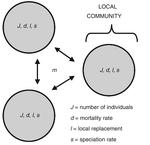Abstract
There has recently been increasing interest in neutral models of biodiversity and their ability to reproduce the patterns observed in nature, such as species abundance distributions.
Here we investigate the ability of a neutral model to predict phenomena observed in single-population time series, a study complementary to most existing work that concentrates on snapshots in time of the whole community. We consider tests for density dependence, the dominant frequencies of population fluctuation (spectral density) and a relationship between the mean and variance of a fluctuating population (Taylor’s power law). We simulated an archipelago model of a set of interconnected local communities with variable mortality rate, migration rate, speciation rate, size of local community and number of local communities. Our spectral analysis showed ‘pink noise’: a departure from a standard random walk dynamics in favor of the higher frequency fluctuations which is partly consistent with empirical data.
We detected density dependence in local community time series but not in metacommunity time series. The slope of the Taylor’s power law in the model was similar to the slopes observed in natural populations, but the fit to the power law was worse. Our observations of pink noise and density dependence can be attributed to the presence of an upper limit to community sizes and to the effect of migration which distorts temporal autocorrelation in local time series.
We conclude that some of the phenomena observed in natural time series can emerge from neutral processes, as a result of random zero-sum birth, death and migration. This suggests the neutral model would be a parsimonious null model for future studies of time series data.
